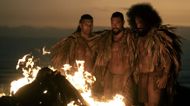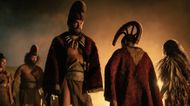On Apple TV+, Chief of War unfolds as a historical drama centered on the unification of the Hawaiian Islands in the late 1700s. Jason Momoa takes on the role of Kaʻiana, a warrior chief whose loyalty fractures during Kamehameha I’s bloody campaign.
The series began streaming on August 1, 2025, with two episodes arriving at once before settling into a weekly release that runs through September 19. Shot across Hawaii and New Zealand, it delivers eight episodes, each between forty to fifty-nine minutes, with dialogue alternating between Hawaiian and English.
Promoted as an authentic retelling of Native Hawaiian history, the production relied on cultural advisors and recreated traditional practices on screen. Yet with that dedication to realism comes difficult subject matter. Battles dominate much of the story, showing spears and clubs used in graphic detail, executions carried out without hesitation, and moments of cruelty that linger.
Viewers will also notice nudity, though only in the sense of traditional Hawaiian attire which exposes bare skin but is not sexualized. Language is minimal but includes occasional profanity. For parents weighing its value for younger audiences, the series offers cultural and historical depth but presents it through violence and intensity that demand a mature perspective.
Is Apple TV+’s Chief of War too intense for younger viewers?

When parents think about whether Chief of War is appropriate for younger viewers, the first factor to consider is the violence. This is not background action or stylized fighting but direct, graphic combat meant to show the brutality of Hawaiian warfare. In the first two episodes, battle sequences show men and women impaled by spears, skulls crushed with clubs, and victims thrown into fires.
One character is stabbed in the back in close detail, and another scene depicts executions of unarmed people hiding in sacred grounds. These are not brief flashes but extended depictions that are hard to avoid even if viewers avert their eyes.
Cruelty sits alongside combat throughout the series. In one moment, a character confronts the remains of his father, an image that is both emotional and unsettling. Elsewhere, the story shows non-combatants and farmers targeted for execution, emphasizing that the violence is not softened or sanitized and carries significant moral weight. The approach underlines a commitment to portraying conflict as it was rather than reshaping it for comfort.
Nudity also appears, though only through traditional Hawaiian clothing. Bare torsos and buttocks are common, as costumes reflect historical accuracy rather than sexual intent. Even so, younger viewers may notice the exposure, and parents who prefer to avoid such content should be aware of how often this traditional dress is shown.
Language is present but not heavy. Words like “sh*t” and “damn” appear in dialogue, which is mild compared to the level of violence shown. Still, parents who want to avoid offensive language for younger children should take this into account.

Language plays a smaller role. Dialogue includes mild profanity such as “sh*t” and “damn,” which is minimal compared to the frequent battle violence, but still worth noting for cautious families.
Emotional heaviness ties everything together. Characters face betrayal, war decisions, and loss in ways that make the story weigh on the audience long after watching. Teenagers may appreciate the cultural and historical detail, but the brutality and intensity are likely too much for children. In the end, Chief of War fits older teens and adults, not younger audiences.
Follow for more updates.
